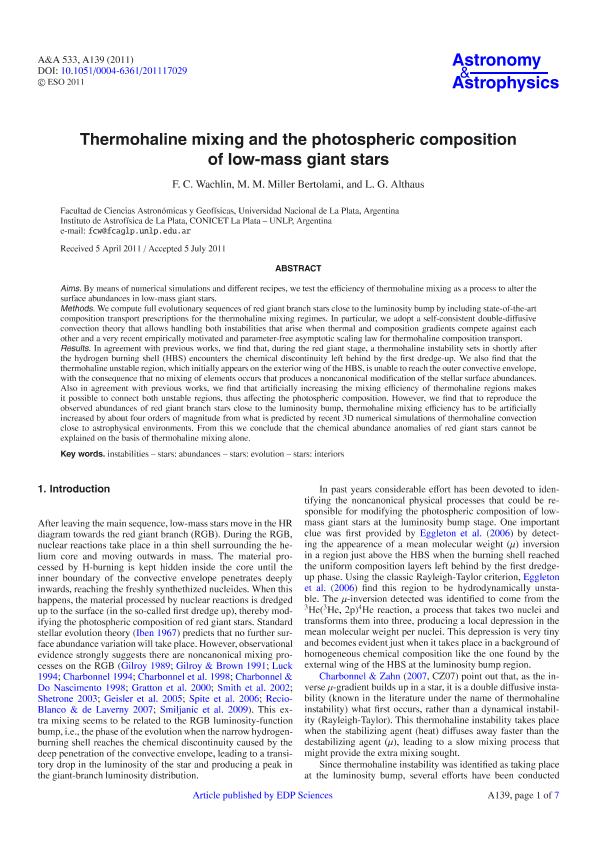Mostrar el registro sencillo del ítem
dc.contributor.author
Wachlin, Felipe Carlos

dc.contributor.author
Miller Bertolami, Marcelo Miguel

dc.contributor.author
Althaus, Leandro Gabriel

dc.date.available
2016-12-26T14:22:35Z
dc.date.issued
2011-09
dc.identifier.citation
Wachlin, Felipe Carlos; Miller Bertolami, Marcelo Miguel; Althaus, Leandro Gabriel; Thermohaline mixing and the photospheric composition of low-mass giant stars; Edp Sciences; Astronomy And Astrophysics; 533; a139; 9-2011; 139-145
dc.identifier.issn
0004-6361
dc.identifier.uri
http://hdl.handle.net/11336/10069
dc.description.abstract
Aims. By means of numerical simulations and different recipes, we test the efficiency of thermohaline mixing as a process to alter the surface abundances in low-mass giant stars.
Methods. We compute full evolutionary sequences of red giant branch stars close to the luminosity bump by including state-of-the-art composition transport prescriptions for the thermohaline mixing regimes. In particular, we adopt a self-consistent double-diffusive convection theory that allows handling both instabilities that arise when thermal and composition gradients compete against each other and a very recent empirically motivated and parameter-free asymptotic scaling law for thermohaline composition transport.
Results. In agreement with previous works, we find that, during the red giant stage, a thermohaline instability sets in shortly after the hydrogen burning shell (HBS) encounters the chemical discontinuity left behind by the first dredge-up. We also find that the thermohaline unstable region, which initially appears on the exterior wing of the HBS, is unable to reach the outer convective envelope, with the consequence that no mixing of elements occurs that produces a noncanonical modification of the stellar surface abundances. Also in agreement with previous works, we find that artificially increasing the mixing efficiency of thermohaline regions makes it possible to connect both unstable regions, thus affecting the photospheric composition. However, we find that to reproduce the observed abundances of red giant branch stars close to the luminosity bump, thermohaline mixing efficiency has to be artificially increased by about four orders of magnitude from what is predicted by recent 3D numerical simulations of thermohaline convection close to astrophysical environments. From this we conclude that the chemical abundance anomalies of red giant stars cannot be explained on the basis of thermohaline mixing alone.
dc.format
application/pdf
dc.language.iso
eng
dc.publisher
Edp Sciences

dc.rights
info:eu-repo/semantics/openAccess
dc.rights.uri
https://creativecommons.org/licenses/by-nc-sa/2.5/ar/
dc.subject
Instabilities
dc.subject
Abundances of Stars
dc.subject
Evolution of Stars
dc.subject
Interior Stars
dc.subject.classification
Astronomía

dc.subject.classification
Ciencias Físicas

dc.subject.classification
CIENCIAS NATURALES Y EXACTAS

dc.title
Thermohaline mixing and the photospheric composition of low-mass giant stars
dc.type
info:eu-repo/semantics/article
dc.type
info:ar-repo/semantics/artículo
dc.type
info:eu-repo/semantics/publishedVersion
dc.date.updated
2016-12-14T12:55:48Z
dc.journal.volume
533
dc.journal.number
a139
dc.journal.pagination
139-145
dc.journal.pais
Francia

dc.description.fil
Fil: Wachlin, Felipe Carlos. Universidad Nacional de la Plata. Facultad de Ciencias Astronómicas y Geofísicas; Argentina. Consejo Nacional de Investigaciones Científicas y Técnicas. Centro Científico Tecnológico La Plata. Instituto de Astrofísica de La Plata; Argentina
dc.description.fil
Fil: Miller Bertolami, Marcelo Miguel. Consejo Nacional de Investigaciones Científicas y Técnicas. Centro Científico Tecnológico La Plata. Instituto de Astrofísica de La Plata; Argentina. Universidad Nacional de la Plata. Facultad de Ciencias Astronómicas y Geofísicas; Argentina
dc.description.fil
Fil: Althaus, Leandro Gabriel. Consejo Nacional de Investigaciones Científicas y Técnicas. Centro Científico Tecnológico La Plata. Instituto de Astrofísica de La Plata; Argentina. Universidad Nacional de la Plata. Facultad de Ciencias Astronómicas y Geofísicas; Argentina
dc.journal.title
Astronomy And Astrophysics

dc.relation.alternativeid
info:eu-repo/semantics/altIdentifier/doi/http://dx.doi.org/10.1051/0004-6361/201117029
dc.relation.alternativeid
info:eu-repo/semantics/altIdentifier/url/http://www.aanda.org/articles/aa/abs/2011/09/aa17029-11/aa17029-11.html
Archivos asociados
